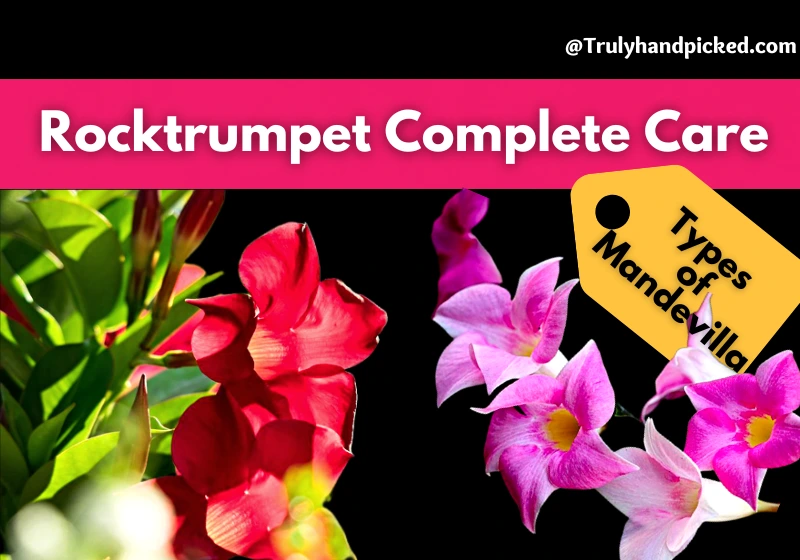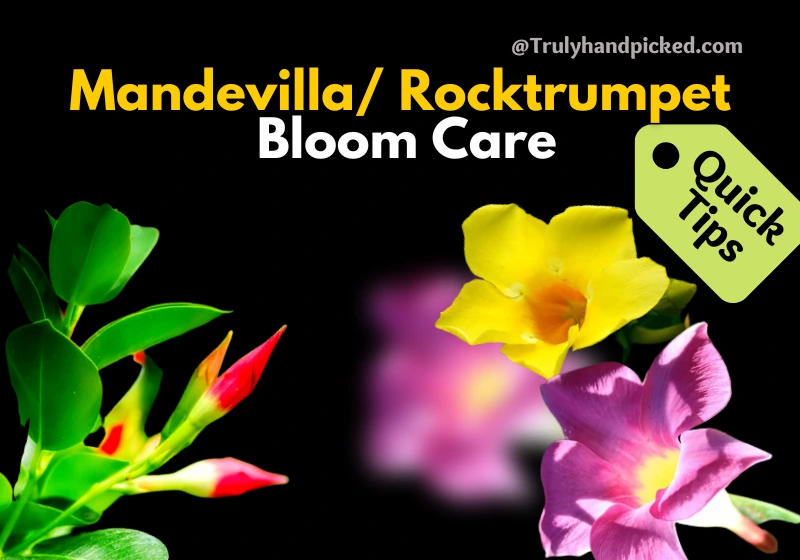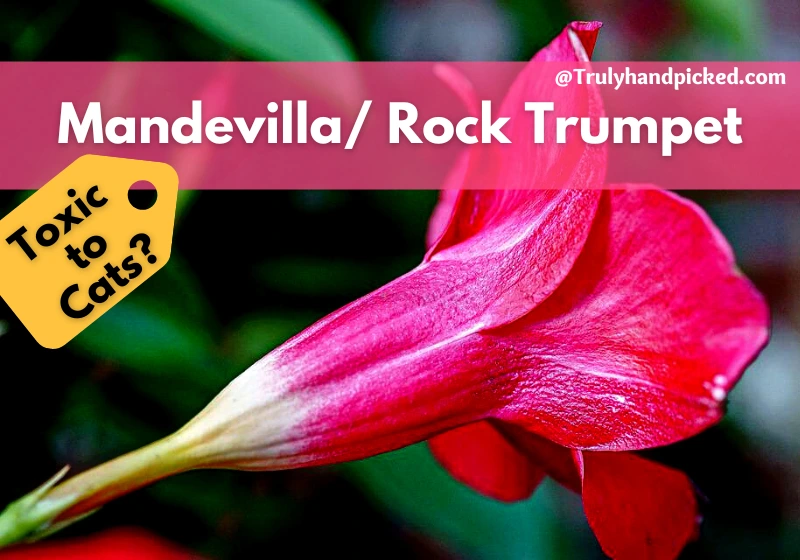Mandevilla is one bright-colored flowering vine that can lighten up your place with a dash of tint. If you want to decorate your indoor or outdoor garden with bright shades of blooms in the cluster, go with a Mandevilla vine.
Mandevilla aka rock-trumpet is one of the most easy-to-grow flowering vines that can thrive in tropical and subtropical climates smoothly.
No matter whether you are an expert gardener or a novice, Mandevilla is one of those plants, which can cultivate through the quickest and easiest way of gardening.
Here are some must-known growing facts you should know about the Mandevilla plant to give it the best thrive you could-
Mandevilla / Rocktrumpet Complete Care:
Soil: A Mandevilla vine likes soil that is sandy, rich with organic food like leaf mold, and balanced with peat moss. Make sure the soil has a well-drained quality and contains neutral to acidic pH levels.
Water: Water your Mandevilla plant once every week to keep the soil consistently moist. Mandevilla vines prefer evenly moist soil that is not soggy ever. Let the topsoil surface dry a little between watering.
Fertilizer: Feed your plant with a slow-released balanced fertilizer during the peak growing season like spring. For regular fertilization, you can apply any liquid fertilizer in half-strength form every 2-3 weeks or at least once a month.
Sun Exposure: Mandevilla vines can tolerate full sun exposure. Try to let your plant thrive under direct and bright sunlight for at least 6-8 hours a day. If you can’t provide the plant with direct sunlight, make sure it can grab bright light for at least 8-10 hours every day.
Climate: As Mandevilla vines are native to tropical and subtropical climates, they prefer a warm environment to thrive. Keep the temperature anything between 60° to 75° F and the humidity level always high. You can try an artificial humidifier or daily misting to keep the level up.
Pruning: Mandevilla are quick-growers and thus you must prune your plant once or twice a year consistently. Do the trimming process during a period the frost passes and spring comes. Always use a clean as well as disinfected pruner and remove all the old blossoms attentively along with the disturbing foliage.
Repotting: Repotting is essential either as pruning, but be alert for not using too much larger pot during a replantation process. You should remember that a 3x-4x larger planter than the root ball can cause the root-bound of your Mandevilla plant. Wait till the vine is completely overgrown the planter and do the process very carefully without causing any damage to the roots during this course.
Pests and Bug Issue: Whiteflies, aphids, spider mites, scales, mealybugs, etc. are some common insects you may face with a growing Mandevilla plant.
Try to apply more natural remedies this time to keep the fragile vines and sensitive flowers of the Mandevilla plant harmless.
Flush of water or wiping with clean clothes or cedar mulching is the easiest way to keep them away effectively.
Types of Mandevilla:
Mandevilla or rock-trumpet plant has more than 100 different species in this same category. They are just dissimilar in their colors of blossoms and size.
Among them, a few are popular as the favorite houseplants, due to their smooth adaptability.
Here are the best 5 types of Mandevilla species you can pick to grow in your outdoor or indoor garden without any worry-
- Mandevilla Splendens: This is one of the bushiest Mandevilla species around. It can thrive up to 10 feet tall and 8 inches in width. You can grow this species easily in a container with moderate care.
- Mandevilla Sanderi: This species of Mandevilla is a short grower and reaches only 15 inches in length while fully grown. It produces stunning red flowers around deep green foliage with a moderately bushy 2-and-a-half-inch wide texture.
- Mandevilla Laxa: It is one more giant Mandevilla species that can grow up to 20 feet tall with proper thriving space. It is one of the hardest categories of the Mandevilla family that produces extremely fragrant flowers in vibrant shades.
- Mandevilla Jamesonii: This is an exclusive species of Mandevilla that can grow only 5 feet tall with full care and thus easily manageable for indoor gardening. This genus is native to the tropical moist montane forest and thus prefers high humidity to thrive.
- Mandevilla Boliviensis: It is one famous species of Mandevilla due to its elegant white blossoms. This species can grow up to 10 feet tall with proper growing space along with a bushy texture of 3-6 feet in width.
How to Get Mandevilla To Bloom?
Mandevilla plants are only appreciated for their beautiful flowers, which are vibrant and fragrant sometimes. So, there is no point in tolerating no-blooming or average blooming issues of this species in any circumstances, isn’t it?
Here are some smart tricks to boost the blooming quality of your Mandevilla plant more efficiently.
Fortunately, these tips not only faster the blooming eminence in your plant but also increase the quantity of blooming efficiently. Let’s take a quick look at these tricks below-
- Place your plant in a spot where it can grab the highest amount of direct sunlight throughout the day
- Planting a Mandevilla plant in a pot is a clever trick indeed. So then, you can chase the light according to the position of the sun
- Never let your plant grow at a temperature below 50° F, even during the night
- Feed your plant consistently and steadily throughout the entire growing season
- Try fertilizing every 2-3 weeks with a diluted form of balanced fertilizer
- And make the soil fertile enough during the plantation so, you can give your plant a kick start
- Keep the phosphorus level of the plant high in your fertilizer, it helps the blooming naturally
- Above all keep your plant safe from the attacks of pests or bugs attentively to keep the blooming quality ineffective from every aspect.
Mandevilla Propagation:
You can mandevilla propagate a mandevilla plant easily even from seeds by following some basic growing tips. However, growing from seeds is quite a longer procedure, rather than regrowing it from a stem cutting. So, here is a quick overview of how to do the propagation properly-
Supplies You Need:
- A sterilized pruner
- Some rooting hormone
- A plastic bag
- A terracotta planter
- Some potting mix
- And a watering can
How to Do It:
- Cut a stem out of the parent vine that must be 4-5 inch long and has some fresh leaves
- Mae sure you cut its stem exactly below the node
- Remove all but the top leaves and dip the end in a rooting hormone
- Place the cutting in a plastic bag and sprinkle some water on the cutting delicately
- Make a hole in the bag to make the humidity level suitable for the cutting
- Let this cutting this way in a warm spot of the house with a bright light source
- You will find that new roots will come out within 4-5 weeks
- When the root s 1-2 inches long, take the cutting out of the bag and replant it
- To replant the cutting, bring a pot filled with the preferred potting mix
- Be certain that you prepare the potting mix with an adequate amount of sand, peat moss, organic fertilizer, and normal potting soil
- Place the planter in a warm climate after watering thoroughly and let it thrive naturally then.
Is Mandevilla Poisonous to Cats?
According to the report or ASPCA, Mandevilla is not of those plants, which are specially listed as a non-toxic plant for your cats. However, ingestion could initiate some indigestion in the stomach of your furry pet.
Despite not being a poisonous plant or having any toxic properties, the Mandevilla plant is inedible. So, you must keep your cat safe from gulping it anyhow. However, playing around with a Mandevilla is quite unstressed for you as well as your cat from any facet.



